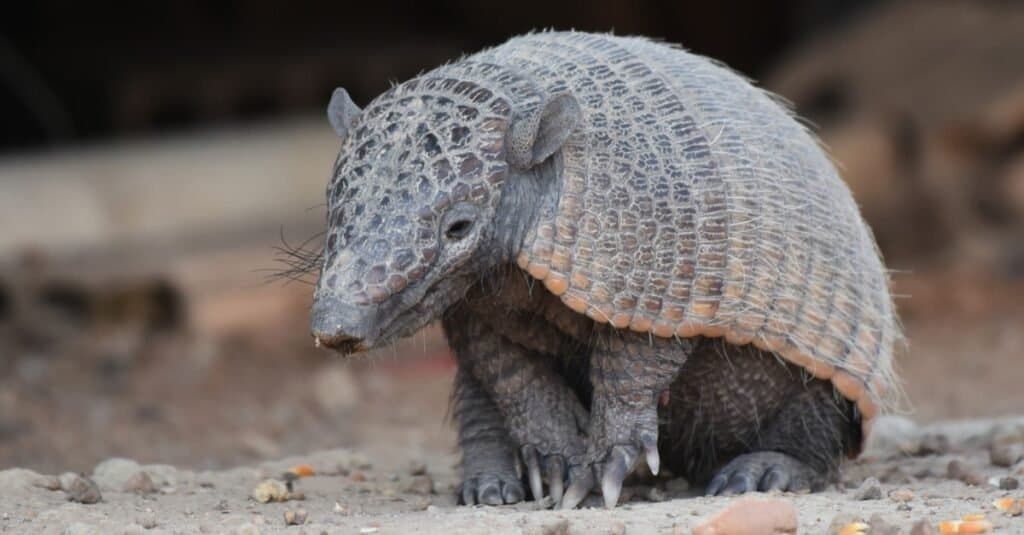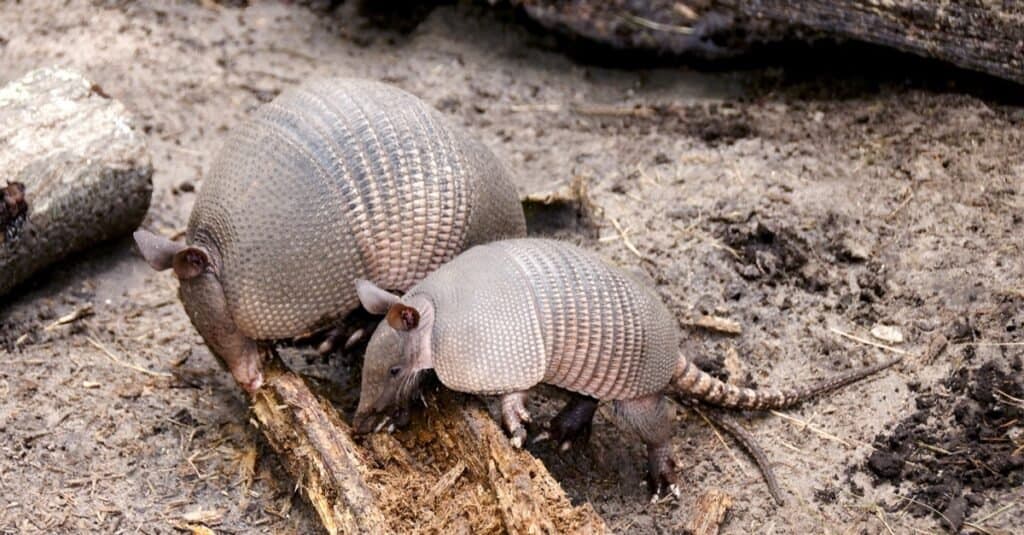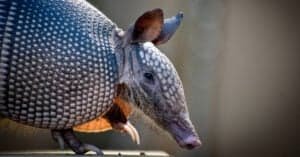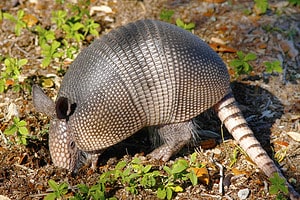Quick Answer:
- No, armadillos are not dangerous as long as they are left alone. They are not confrontational unless they feel cornered or threatened by a human.
- An armadillo may be able to transmit Hansen’s disease, formerly known as leprosy, to humans through scratching with its claws.
Armadillos are a group of 21 armored placental mammals belonging to Central and South America’s tropical and subtropical regions. In the United States, the most well-known, the nine-banded armadillo, is found in various habitats spanning as far north as Nebraska and as far west as New Mexico. Even though they may spread diseases, armadillos are not dangerous to humans in general.
Although armadillos are relatively harmless, it’s crucial to remember that they are wild animals that can potentially spread diseases if touched or eaten.
Are Armadillos Dangerous?

Armadillos are not dangerous to humans in general, but they can spread diseases if touched or eaten.
©http://www.birdphotos.com, CC BY 3.0, via Wikimedia Commons – License
Unless you try to grab one, an armadillo is unlikely to pay you any attention if you notice one waddling by. Armadillos do not bite because their lips and teeth are too tiny to crush food. They rarely attack humans and pets, although it is always a possibility when they feel threatened. However, there are more armadillo threats than most of us are aware of, including spreading diseases.
Is It Dangerous To Touch An Armadillo?
If you live in the southern United States, armadillos may be able to transmit Hansen’s disease, formerly known as leprosy, to humans. Mycobacterium leprae is the bacterium that causes the infection, and armadillos naturally carry the bacteria.
Hansen’s disease can impact the nervous system, skin, eyes, and nasal lining (nasal mucosa). The condition can be cured if diagnosed and treated early enough. If the symptoms are not treated, it can lead to permanent nerve damage, paralysis, blindness, and other serious consequences. However, the likelihood of contracting Hansen’s disease by encountering an armadillo is quite low.
How Do Armadillos Spread Leprosy To Humans?

Armadillos can spread leprosy, also known as Hansen’s disease, to people and pets through direct contact.
©iStock.com/Rini Kools
Armadillos are the most common creatures capable of transmitting leprosy to humans, and they do so by attacking with their claws. The disease is then transmitted from person to person through aerosol infection, such as coughing and sneezing. In most cases, infection necessitates living near an untreated diseased person. The infection has been found in both cats and dogs that have had contact or an attack from an Armadillo.
Are Armadillos Territorial?
Armadillos aren’t territorial and will leave if better feeding grounds become available. Other burrowing species, such as snakes, skunks, and rats, frequently reside in their abandoned homes.
Can You Keep An Armadillo As A Pet?
Armadillos should not be tamed in the same way that dogs or cats are tamed. They are wild animals that require a lot of space to dig and move about, making them tough to care for. In addition, they are known to carry diseases transferrable to humans and other pets.
Do Armadillos Have Scales?

Armadillos have thick shells that cover them, produced from their skin.
©Rose Waddell/Shutterstock.com
Armadillos have plates that cover them, known as carapaces. This collection of plates covers much of the body, including the head, legs, and tail. The carapace comprises bony transverse bars coated in thick scales produced from the skin. Some armadillo species have almost hairless shells, while others have long, coarse hairs protruding from their shells.
Do Armadillos Have Teeth?
Armadillos have a lot of teeth, about 14 to 18 per jaw. Their jaws don’t open all the way, much like anteaters; they catch their meals with their tongues.
Do Armadillos Have Claws?
Yes, armadillos have strong legs and large front claws used for digging burrows.
What Do Armadillos Eat?

Armadillos eat plants, fruits, and bugs mostly.
©Photo by Michael Overton, CC BY-SA 3.0, via Wikimedia Commons – License
Armadillos eat tiny vertebrates, plants, and fruit in addition to bugs. Ants and termites are extracted from burrows with their long, sticky tongues.
Where Do Armadillos Live?
Armadillos are found in various temperate and warm environments, such as rainforests, grasslands, and semi-deserts. They dislike cold weather because of their poor metabolic rate and lack of fat.
Are Armadillos Good Or Bad To Have Around?
Armadillos can be good to have around because they consume insects and other invertebrates. However, they mostly may be a nuisance when digging up lawns, gardens, and flower beds. Their tunneling under foundations, driveways, and other structures has caused some damage. An armadillo abundance can present potential health issues if you have small pets or children.
Use castor oil-based repellant to keep armadillos away from your property and keep them from digging for food. To deter armadillos from eating their prey, castor oil is an all-natural oil that reaches the soil and contaminates their food sources, making them unappetizing to eat.
The photo featured at the top of this post is © iStock.com/6381380
FAQs (Frequently Asked Questions)
Is An Armadillo Considered A Rodent?
The armadillo, contrary to popular belief, is neither rodent nor marsupial. Armadillos come in twenty different species. Sloths and anteaters are their closest living cousins.
Are Armadillos Nocturnal?
Nine-banded armadillos, sleep for up to sixteen hours during the day by burrowing underground and spend their waking time digging or feeding.
Thank you for reading! Have some feedback for us? Contact the AZ Animals editorial team.







